Institute of Oceanology, Chinese Academy of Sciences
Article Information
- YOLANDA Rofiza, LHEKNIM Vachira
- Population structure and reproductive biology of the mysid Nanomysis siamensis (Crustacea: Mysida) in Songkhla Lagoon system, southern Thailand
- Journal of Oceanology and Limnology, 39(3): 997-1009
- http://dx.doi.org/10.1007/s00343-020-0069-7
Article History
- Received Jan. 29, 2020
- accepted in principle Apr. 4, 2020
- accepted for publication Jun. 17, 2020
Mysids are dominant coastal and estuarine organisms (Mees and Hamerlynck, 1992; Mees et al., 1993; Azeiteiro and Marques, 1999; Granda et al., 2004). They are omnivores that feed on detritus, phytoplankton, and zooplankton (Fockedey and Mees, 1999), and play an important role in the transfer of energy from primary food sources towards secondary consumers at a higher trophic level (Mees and Jones, 1997; Viherluoto, 2001; Stewart et al., 2009). Some of them also serve as a food source for human consumption (Mauchline, 1980; Mantiri et al., 2012).
These small crustaceans have been studied throughout the world. However, biological and ecological studies on them in tropical regions are still lacking compared to the abundant studies in temperate regions, such as from USA (Allen, 1984; Turpen et al., 1994; Pothoven et al., 2000), Norway (Kjellberg et al., 1991), Japan (Ikeda, 1992; Yamada et al., 2007; Chikugo et al., 2013), Netherlands (Mees and Hamerlynck, 1992; Mees et al., 1993, 1994; Rappé et al., 2011), Spain (Baldó et al., 2001; Delgado et al., 2013), Germany (Scharf and Koschel, 2004). Most studies on Southeast Asian mysids have focused on taxonomy, for example from Indonesia (Nouvel, 1957; Bacescu, 1993; Hanamura et al., 2008a, 2011; Bamber and Morton, 2012; Hanamura et al., 2014), Malaysia (Hanamura et al., 2008a, 2011; Tan and Azman, 2017, 2018), Philippines (Murano, 1997; Hanamura et al., 2011) and Thailand (Tattersall, 1921; Murano, 1988; Fukuoka and Murano, 2002; Hanamura et al., 2008a, 2011; Moriya et al., 2015), with few studies on seasonal abundance (Hanamura et al., 2008b; Biju et al., 2009, 2010; Biju and Panampunnayil, 2010, 2011; Ramarn et al., 2012). Since the population and life history of shallow water mysids differ at spatial and temporal scales between tropical and temperate regions (Mauchline, 1980), studies are needed to provide more information about the organisms.
The Songkhla Lagoon system (also known as Songkhla Lake) is one of the largest lagoons in southern Thailand (1 040 km2) and can be characterized by its shallow depth (approximately 1 to 2 m), muddy and sandy substrate and large variation in salinity (0 to 33). Although numerous studies on benthic fauna and small crustaceans have been carried out in this lagoon system, information about mysids is limited. The first data on the mysids in this lagoon were reported by Tattersall in 1921 with two species, Nanomysis siamensis and Rhopalophthalmus egregius (now R. orientalis, see Tattersall (1957)) from Thale Sap, and to date (almost 100 years), only one species has been identified as a new species (Yolanda et al., 2019). Other aspects of the biology of the mysids, such as population, distribution, and reproduction have not been recorded from this lagoon, especially for N. siamensis that is very abundant in this lagoon. Due to its abundance, this mysid is projected to play an important role in this ecosystem, and information about its biology is crucial to the provision of comprehensive data to improve fisheries management and aquaculture in the lagoon. The objective of the present study is thus to provide basic information on the population structure and reproductive biology of N. siamensis in the waters of Thale Sap and Thale Sap Songkhla, Songkhla lagoon system, southern Thailand.
2 MATERIAL AND METHOD 2.1 Sampling procedureDiurnal sampling was carried out monthly at five stations in Thale Sap and at seven stations in Thale Sap Songkhla (Fig. 1) from June 2017 to June 2018 except December 2017 when extreme weather conditions prevented sampling. Both of the main lagoons have different water salinity characteristics, where Thale Sap is always influenced by freshwater inflow, and Thale Sap Songkhla is influenced by seawater from the Gulf of Thailand. At each station, samples were collected at two sites with three replicates each in the littoral zone approximately 200 m from the shore. The distance between sites at any given station was approximately 100 m, and the environmental conditions were always similar between both sites. Within-site replication was intended to increase sample size and avoid bias due to the likelihood of zero-abundance records in individual samples. Mysids were collected with a modified Riley hand push-net with two nets (mouth area 0.50 m×0.30 m; mesh openings 0.5 and 2 mm) that could reach the bottom of the lagoon. The net was pushed by hand while walking through the shallow zone of the lagoon for 30 m at depths of 50 to 150 cm. Densities of the mysid were calculated as the number of individuals per 100 m2 (inds./100 m2), which was swept by the net (net width×distance of tow). Mud and debris were cleaned from the samples and the entire contents were then washed into a sample bottle and fixed with 4% lagoon water-buffered formalin and rose bengal. Environmental variables (temperature, salinity, and pH) were measured at the surface during sampling sessions. Temperature and salinity with a digital AZ instrument (AZ 8371) and pH with an Adwa instrument (AD12).
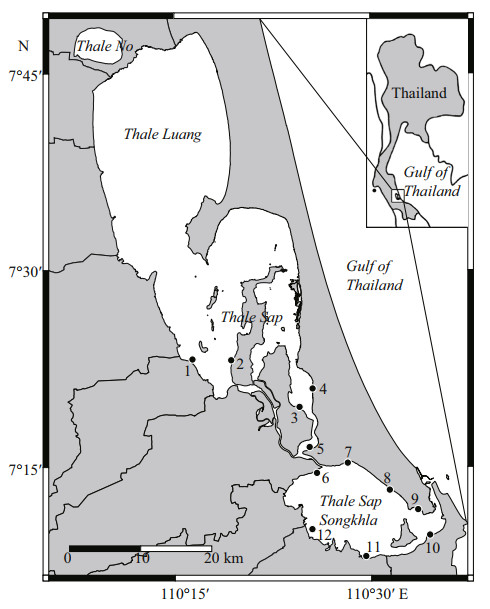
|
| Fig.1 Twelve sampling stations (black dots) in Songkhla Lagoon, southern Thailand |
In the laboratory, N. siamensis and other mysids were sorted and counted under a stereomicroscope, and mysid density per station was calculated as inds./100 m2. Body length (BL) was measured from the anterior margin of the rostrum to the posterior end of the telson excluding apical spines (Ramarn et al., 2012) for 200 individuals (when available), with an ocular micrometer mounted on a stereomicroscope. Each individual was then classified into one of six main categories based on their reproductive and sexual characteristics, following Mauchline (1980): (1) juveniles, without secondary sexual characteristics; (2) immature males, with developing secondary sexual characteristics (4th pleopod); (3) immature females, with undeveloped marsupial or brood pouch; (4) mature males, with completely developed secondary sexual characteristics; (5) mature females, with completely developed secondary sexual characteristics and empty marsupia; and (6) ovigerous or brooding females, with embryo or larvae in the marsupium. In the case of brooding females, the brood was classified into one of three categories of development according to San Vicente et al. (2014): embryonic phase, the marsupium contained eggs or embryos; nauplioid stage, embryo developed into larvae but without eyes and post-nauplioid stage, molted larvae presented with stalked eyes and thoracic appendages. Embryos and larvae were also measured. The embryo diameter was measured along the longest axis, and lengths of the larvae were measured from the frontal to the terminal tip of the body.
2.3 Data analysisA two-way ANOVA test was performed to evaluate the differences in the abundance and body size of each category of N. siamensis among months and between the two lagoons. Development was also analyzed descriptively. Significant differences in the proportion of sex ratio (Thale Sap, Thale Sap Songkhla and combination of the two lagoons) and in brooding females (combination of Thale Sap and Thale Sap Songkhla) were tested with the chi-square tests. Specific differences in the brood size (embryo, nauplioid and post-nauplioid stage) and body length of brooding female were tested with one-way ANOVA and post hoc Tukey's HSD. Multiple linear regressions were used to investigate any correlation between the body length of brooding females with the brood size and length of brood members (embryo, nauplioid, and post-nauplioid stage). The value of the standard error (±SE) is presented after the mean value. All the data were tested for normality and homoscedasticity, failing data were transformed with log (n+1) (Sokal and Rohlf, 1995) and statistical analyses were performed using Statistix 10.0.
3 RESULT 3.1 Environmental variablesMeasurements of water temperature, salinity, and pH from June 2017 to June 2018 are presented in Fig. 2a–c, with the exception of temperature in June 2017 due to equipment malfunction. At Thale Sap, monthly mean water temperatures fluctuated throughout the study period between 25.81 and 31.41 ℃, with an overall mean of 29.40±1.91 ℃. Although the water temperature exhibited a slight peak during October 2017, monthly variation was generally minor. In contrast, the mean monthly salinity exhibited a temporal variation, from 0 to 11.01, with an overall mean of 3.49±3.48. The pH ranged from 6.45 to 10.2. At Thale Sap Songkhla, the mean monthly water temperatures ranged from 26.75 to 31.01 ℃, with an overall mean of 29.02±1.12 ℃; the mean salinity exhibited monthly fluctuations from 0 to 22.06 with an overall mean of 8.71±7.39; and the pH ranged from 6.7 to 9.3.
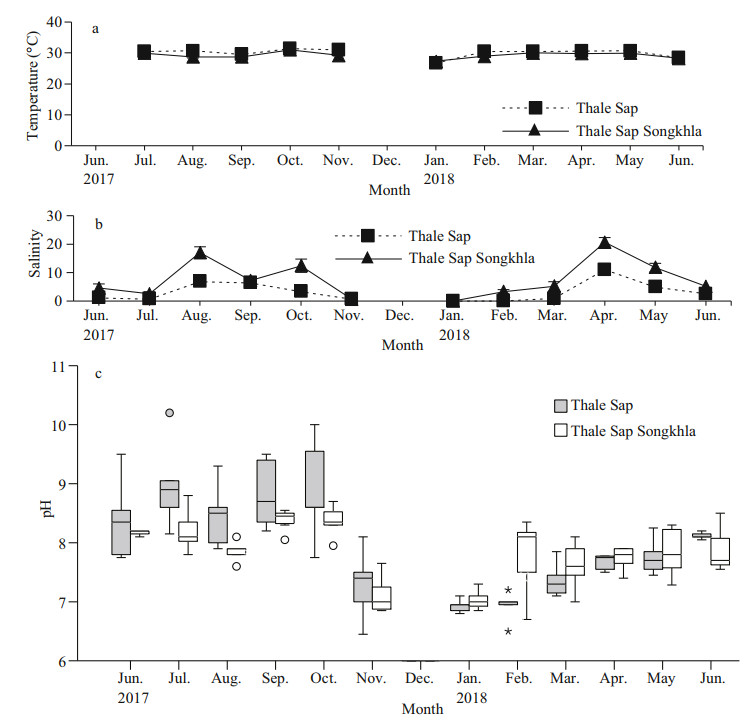
|
| Fig.2 Monthly water variables (June 2017–June 2018) at Thale Sap and Thale Sap Songkhla, Songkhla lagoon, southern Thailand a. temperature (mean±SE); b. salinity (mean±SE); c. pH. The temperature data for June 2017 are not available because of equipment malfunction. The circles and stars in (c) indicate the minimum and maximum outliers of the pH value. |
The monthly mean population densities of N. siamensis during this study exhibited significant temporal variation (Fig. 3). In Thale Sap, density increased from June to August 2017; however, from September 2017, the trend reversed, reaching the lowest density in November 2017, and then rising again from January 2018 to a peak density in May 2018. Overall, the mean density ranged from 8.44 to 807.33 inds./100 m2. In contrast, in Thale Sap Songkhla, the density showed a downward trend from July to September 2017 with an increase from October 2017, reaching maximal density in November 2017. However, from January 2018 density declined, reaching a minimal value in March 2018. The mean density ranged 8.81–434.44 inds./100 m2. Overall, monthly mean densities of N. siamensis were higher in Thale Sap than in Thale Sap Songkhla except in October 2017, November 2017 and June 2018, and there was a significant abundance difference among the population from Thale Sap and Thale Sap Songkhla with monthly collection. Detailed results of the statistical analysis are shown in Table 1.
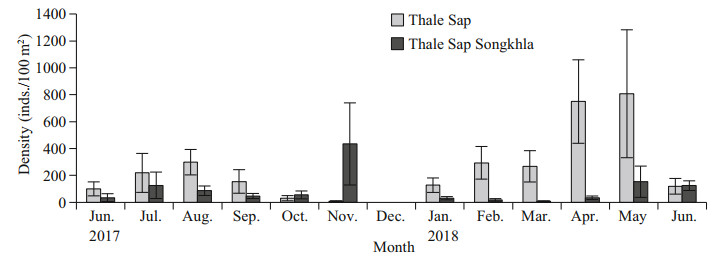
|
| Fig.3 Monthly mean (±SE) abundance of N. siamensis W. Tattersall, 1921 from Thale Sap and Thale Sap Songkhla, Songkhla Lagoon, southern Thailand (June 2017–June 2018) |
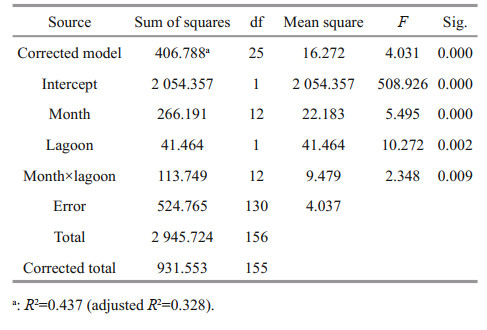
|
Measurements of N. siamensis body size showed variation in each life stage of this mysid (Table 2). The juvenile stage was distinguished by the absence of genitalia and genital appendages, and the size ranged from 1.2 to 2.4 mm in Thale Sap and Thale Sap Songkhla. Immatures were differentiated by the development of the fourth pleopod into immature male, at 2.2 to 3.3 mm in Thale Sap and 2.4 to 3.3 mm in Thale Sap Songkla, and reached maturity with the elongation of the fourth pleopod, which in mature specimens (3.1 to 5.0 mm in Thale Sap and 3.1 to 5.3 mm in Thale Sap Songkla) was elongated as far as the sixth abdominal somite and even the statocyst. In females, oostegites appeared in individuals measuring 2.3 to 3.3 mm in Thale Sap and 2.4 to 3.3 mm in Thale Sap Songkla, and formed a large brood pouch on the ventral side of the thorax in adults. Mature females were collected that measured 3.0 mm and the largest was 5.4 mm in Thale Sap and 6.1 mm in Thale Sap Songkhla. The brood pouch developed into the marsupium and brooding females were found at 2.9 mm in Thale Sap and 3.1 mm in Thale Sap Songkhla, with body lengths up to 5.7 mm in Thale Sap and 5.6 mm in Thale Sap Songkhla. Statistical analysis also showed that there was a significant body length difference among each life stage category (two way ANOVA F5, 16387=15 486.62, P=0.000), between the two lagoons (two way ANOVA F1, 16387=211.88, P=0.000) and also an interaction occurred between the lagoon and each category (two way ANOVA F5, 16387=26.84, P=0.000) (Fig. 4).

|
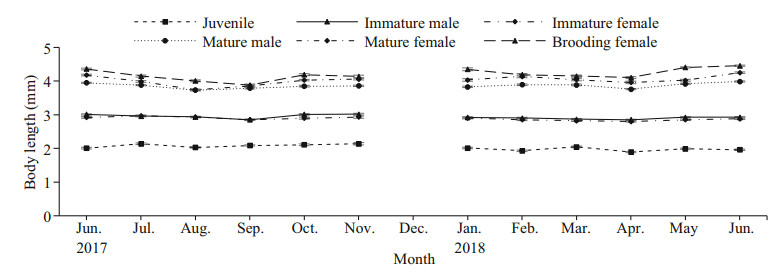
|
| Fig.4 Monthly mean (±SE) variation in body length for each category of N. siamensis W. Tattersall, 1921, from Songkhla Lagoon, southern Thailand (June 2017–June 2018), combined data from Thale Sap and Thale Sap Songkhla |
The populations of N. siamensis in both Thale Sap and Thale Sap Songkhla showed similar trends, in which the mature males were predominant among the six categories (Fig. 5a–b). At Thale Sap, mature males accounted for the largest proportion of the samples with, on average, 26.26% of the whole population; mature females with 21.17%; juveniles, immature males and immature females formed about 9.84%, 13.61%, and 10.61% of the populations, respectively, and ovigerous females contributed approximately 20.19% (Fig. 5a). The highest proportion of mature males was found during January 2018, while the lowest was observed in September 2017. Conversely, the largest proportion of mature females was found in October 2017, with the lowest proportion in April 2018. Juveniles and immature males were most abundant in September 2017 and at their lowest level in October 2017; immature females were equally most abundant in September 2017, but lowest in June 2017. Ovigerous females peaked in May 2018 and were at their lowest abundance in July 2017. There was a significant difference in the sex ratio between males and females at Thale Sap monthly (χ2=205.523, df=11, P=0.00), and females were more predominant than males.
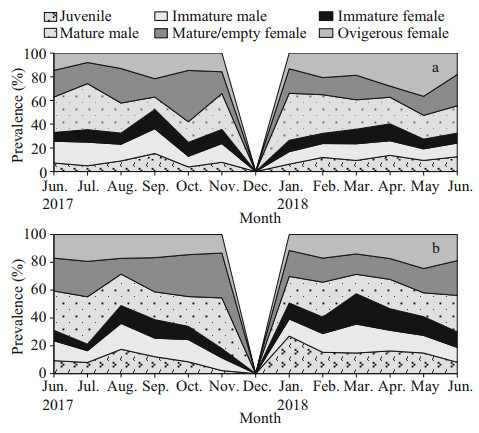
|
| Fig.5 Population structure of N. siamensis W. Tattersall, 1921 from Thale Sap (a) and Thale Sap Songkhla (b), Songkhla Lagoon, southern Thailand (June 2017– June 2018) |
At Thale Sap Songkhla, mature males and mature females formed 24.87% and 22.30% of the whole population, respectively. Juveniles, immature males and immature females were presented at similar levels (11.77%, 12.97%, and 10.90%, respectively). At the same time, ovigerous females formed 17.18% of the population (Fig. 5b). The largest group of mature males was observed in November 2017 and the smallest group was observed in March 2018. The prevalence of mature females was highest and lowest in November 2017 and August 2017, respectively; for juveniles these levels occurred in January 2018 and November 2017, and for immature males and immature females, these level occurred in March 2018 and July 2017, respectively. The largest population of ovigerous females was observed in May 2018 and the smallest was observed in January 2018. There was a significant difference in the sex ratio between males and females at Thale Sap Songkhla monthly (χ2=42.711, df=11, P=0.00), and females were predominant. Overall, the monthly sex ratio between males and females combined from Thale Sap and Thale Sap Songkhla, was 0.77, which was significantly different from 1 (χ2=192.65, df=11, P=0.00), and females were more abundant.
3.4 Brooding female, brood size and lengthOf the brooding females, those in the nauplioid stage accounted for the largest proportion at 50% of the population, while those in the embryonic phase and post-nauplioid stage accounted for 29% and 21% of the population, respectively (Fig. 6). The proportions of these groups were significantly different among months (χ2=39.393, df=22, P=0.013). The mean body length of the brooding females was significantly different between brooding stages (ANOVA F2, 33=4.613, P=0.017); brooding females with postnauplioid stage were the largest, and those in the nauplioid stage were larger than embryonic phase as follows: embryonic phase: 4.03±0.05 mm, nauplioid stage: 4.19±0.05 mm, and post-nauplioid stage: 4.26±0.05 mm. There was no significant size difference between brooding females with nauplioid and post-nauplioid stages (Tukey's HSD, P=0.632), but there was a significant size difference between brooding females in post-nauplioid stage and embryonic phase (Tukey's HSD, P=0.015). The maximum number of embryos, nauplioids and postnauplioids per female were 17 (5.59±0.42), 15 (4.87±0.49), and 15 (4.62±0.43), respectively (Table 3), although these numbers were not statistically significant (ANOVA F2, 33=3.154, P=0.056).
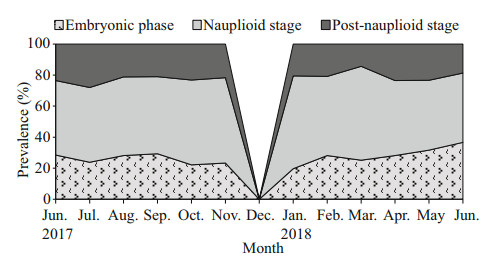
|
| Fig.6 The proportion of brooding females N. siamensis W. Tattersall, 1921 from Songkhla Lagoon, southern Thailand (June 2017–June 2018), combined data from Thale Sap and Thale Sap Songkhla |

|
As expected there was a significant correlation between brood size in the different stages and the body length of the ovigerous females (Fig. 7a) and the correlations can be expressed in the following equations:
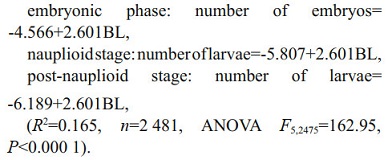
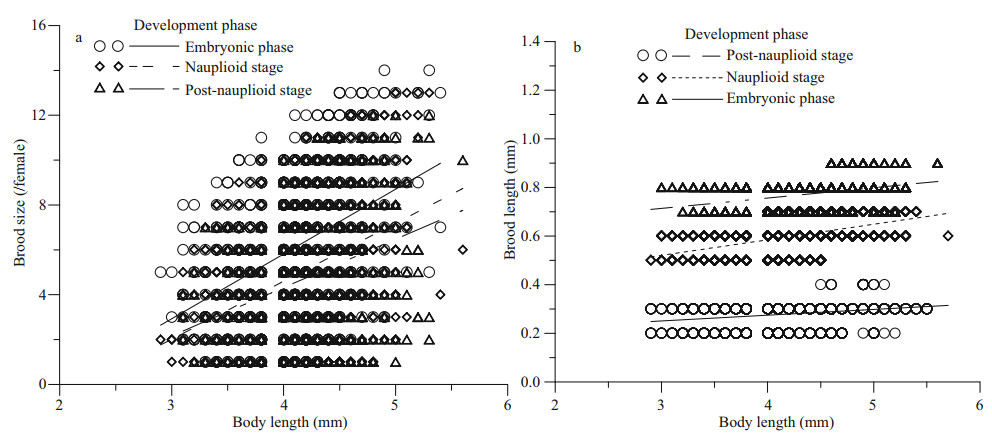
|
| Fig.7 Relationship between brood size (a) and brood length (b) with the body length of brooding females N. siamensis W. Tattersall, 1921 from Songkhla Lagoon, southern Thailand, June 2017–June 2018 |
On the other hand, a significant correlation between brood member length and ovigerous female body length in each brooding stage showed a different increasing trend (Fig. 7b), as expressed in the following equations:
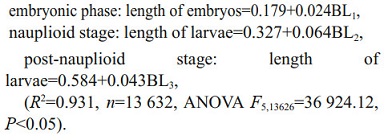
From our observations, the morphology and length of the brood varied within each stage (Fig. 8). Embryo or egg diameter ranged from 0.2 to 0.4 mm (0.28±0.04 mm, n=4 566), the length of nauplioid stage ranged from 0.5 to 0.7 mm, (0.59±0.06 mm, n=6 824) and the length of post-nauplioid stage ranged from 0.5 to 1.0 mm (0.78±0.07 mm, n=2 838). The monthly variation in the brood size is presented in Fig. 9.

|
| Fig.8 Successive phases of development of N. siamensis from Songkhla Lagoon (the embryonic phase and the larval stage with two larval stages) a. embryonic phase; b. nauplioid stage; c. post-nauplioid stage. Scale bar=0.5 mm. The red seen in the nauplioid and post-nauplioid stages is due to the use of rose bengal during preservation. |
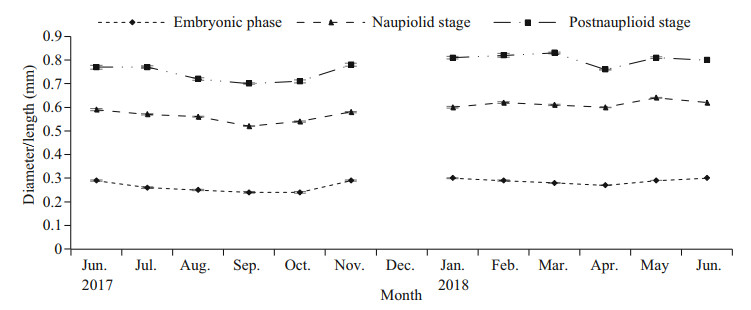
|
| Fig.9 Monthly mean (±SE) variation in the size of the embryonic phase, nauplioid stage and post-nauplioid stage of N. siamensis W. Tattersall, 1921 from Songkhla Lagoon, southern Thailand, June 2017–June 2018 |
The population density of the mysid Nanomysis siamensis showed a wide range of fluctuations in the Songkhla Lagoon system and the density was higher in Thale Sap than in Thale Sap Songkhla. The difference might be related to geographical condition of the two lagoons. The mouth of the lagoon in Thale Sap Songkhla is connected directly with seawater from the Gulf of Thailand, while Thale Sap is located in the upper part of Thale Sap Songkhla. The water condition of Thale Sap Songkhla might fluctuate directly due to the tidal current, which would affect the mysids in this area. Several researchers have noted that the tidal current of the water could influence the distribution of zooplankton and mysids (Wooldridge and Bailey, 1982; Hill, 1991; Hough and Naylor, 1991, 1992; Moffat and Jones, 1993). The total average density of N. siamensis in this study (3.6 inds./m2) is low compared to other mysid species from tropical regions (in Malaysia) such as Acanthomysis thailandica (405 inds./m2) (e.g., Ramarn et al., 2012) and Mesopodopsis orientalis (49 inds./m2 and 709.2 inds./m2) (e.g., Hanamura et al., 2008b, 2009). The variability in the occurrence and abundance of some species of mysids might be related to weather pattern, monsoons, or seasonal behavior and migration (Nair, 1939; George, 1958; Mauchline, 1980; Biju and Panampunnayil, 2011). Overall, the sampling of N. siamensis in the littoral zone using Riley hand push net was effective in representing its occurrence and abundance in the Songkhla Lagoon system.
In the present study, the measured environmental variables showed that variation in water temperature and pH was minor, although a large variation in salinity occurred (Fig. 2a–c). Wangkulangkul (2018) noted that the great variation in salinity at this location may be caused by the rainy season in southern Thailand and that during the rainy season in Songkhla Lagoon there is an increase in the freshwater inflow from Thale Sap to Thale Sap Songkhla. Tropical mysids can be found in water temperatures from approximately 25 ℃ until 35 ℃ and a pH from 6 to 8. Suitable salinity conditions for mysids are freshwater (Gupta and Gupta, 1984) and brackish water to seawater (Hanamura et al., 2008b. 2009; Biju et al., 2009; Biju and Panampunnayil, 2011; Ramarn et al., 2012). Overall, there was no statistically significant correlation between the abundance of N. siamensis and water conditions.
A further biotic factor that might influence the occurrence and abundance of mysids is food availability (Hanamura et al., 2009). Phytoplankton and zooplankton are the main food sources of mysids (Mauchline, 1980; Viherluoto, 2001), and in Songkhla, phytoplankton and copepod communities are found throughout the year with peak occurrence during the northeast monsoon and southwest monsoon, although heavy rain causes some decreases in the communities (Angsupanich and Rakkheaw, 1997; Angsupanich et al., 1997). A further investigation is needed to elucidate the diet composition of the species. Predation by fishes also determines the density of the mysids (Hostens and Mees, 1999; Boscarino et al., 2009; Castro et al., 2013). However, to date, there has been no scientific report about the predation of mysids by fishes or gelatinous plankton in Songkhla lagoon.
The current study of N. siamensis shows that in comparison to males, females reach reproductive maturity at a smaller size than male, while mature females are also larger than mature males (Table 2). Our findings thus contrast to those of Tattersall (1921) who reported that the largest mature male was 5 mm and the largest mature female was 4 mm, as opposed to 5.3 mm and 6.1 mm, respectively, found in this study. Variations in size at sexual maturity of mysids not only exist within populations of a species during different seasons but also between populations in different areas during the same season (Mauchline, 1980). For example, in Malaysia, in comparison adult females, adult males M. orientalis in a mangrove zone reach maturity at a smaller size (Hanamura et al., 2008b), while in a coastal area, adult females matured at a smaller size than adult males (Hanamura et al., 2009). Similarly, adult females Acanthomysis thailandica matured at a smaller size than the adult males (Ramarn et al., 2012). In general, female mysids grow larger than males due to more frequent molts in males and slower growth rates (Mauchline, 1980).
The difference in the sex ratio may be influenced by migration, minimum size variation when secondary sexual characteristics emerge (Mauchline, 1980), species life span, or the variation of male and female mortality rates (Hakala, 1978). In this study, the adult female (combination of mature/empty female and ovigerous female) N. siamensis was significantly more predominant than the adult male (1.53꞉1) annually (χ2=215.854, df=11, P=0.00), with the highest variation found in October 2017. Mauchline (1980) explained that sex ratios within mysid populations are variable, but the number of females is frequently higher than the number of males. The higher proportion of female mysids compared to male mysids has also been reported by other researchers for A. thailandica (Ramarn et al., 2012), Hemimysis lamornae mediterrania (Delgado et al., 2013), M. orientalis (Hanamura et al., 2008b, 2009) and Siriella jaltensis (Delgado et al., 2018).
The continuous reproduction of N. siamensis suggest that spawning occurs throughout the year (Fig. 6). Other species, including A. thailandica, M. orientalis and M. zeylanica, also show year-round reproduction (Hanamura et al., 2008b, 2009; Biju et al., 2009; Biju and Panampunnayil, 2011; Ramarn et al., 2012). Goodbody (1965) also reported that tropical mysids reproduced continuously. However, temperate mysids only produced 2 or 3 short-lived generations a year (Mauchline, 1980). The predominance of the brooding female N. siamensis in the nauplioid stage is due to the duration of larval development in the marsupium. The development of the nauplioid stage takes longer than the development of embryonic phase and post-nauplioid stage is the shortest development stage (Delgado et al., 2013). The brood size and brood length of N. siamensis in this study were positively correlated with the body length of the brooding females (Fig. 7a–b). This indicates that a brooding female with a large body could produce and carry a relatively larger brood in the marsupium (Saltzman, 1996). The present results also showed variation in the brood size of each stage, as the embryo ranged from 1 to 17, while the nauplioid and post-nauplioid stages ranged from 1 to 15 (Table 3). These findings suggest mortality during development in each stage in the brood pouch; however, there was no statistically significant difference. According to Mauchline (1980), the number of young per brood varies greatly between species and sometimes between closely related species. Furthermore, mortality is possible during marsupial development (Mauchline, 1973) due to parasitism (Daly and Damkaer, 1986; Ohtsuka et al., 2011) and cannibalism (Wittmann, 1984). During this study, no evidence of parasitic or cannibalistic activity was found to account for the observed variation in brood size of N. siamensis, although this should be investigated by more detailed studies.
5 CONCLUSIONThe population structure, reproductive traits of N. siamensis and water conditions in Songkhla Lagoon system were assessed from June 2017 to June 2018. Mean temperature and pH showed a minor variation but mean salinity showed a great variation from 0 to 11.01 in Thale Sap and 22.06 in Thale Sap Songkhla. The density of Nanomysis siamensis was greater in Thale Sap (8.44–807.33 inds./100 m2) than Thale Sap Songkhla (8.81–434.44 inds./100 m2) and the peak occurrence was observed in May 2018. The sex ratio showed that adult females were dominant than adult males and reproduction occurred yearround, similar to other tropical mysid species. The species also exhibited a correlation of brood size and brood length with brooding female body length. The continuation of mysid population research in the Songkhla Lagoon system is necessary to be done due to their role in the food chain of the lagoon.
6 DATA AVAILABILITY STATEMENTAll datasets generated and/or analyzed during this study are available from the corresponding author on reasonable request.
7 ACKNOWLEDGMENTWe would like to thank Mr. Naratip Tubtimtong and Mr. Sompong Pachonchit for helping during the field work and we also thank Dr. Sammy De Grave (Oxford University Museum of Natural History) for the correction on this manuscript. Finally, we greatly appreciate the editor and reviewers for the valuable comments to improve the manuscript.
Allen D M. 1984. Population dynamics of the mysid shrimp Mysidopsis bigelowi W.M. Tattersall in a temperate estuary. Journal of Crustacean Biology, 4(1): 25-34.
DOI:10.2307/1547893 |
Angsupanich S, Phromthong I, Srichuer K. 1997. Meiofauna in Thale Sap Songkhla, a lagoonal lake in Southern Thailand. Science Asia, 23(4): 347-358.
DOI:10.2306/scienceasia1513-1874.1997.23.347 |
Angsupanich S, Rakkheaw S. 1997. Seasonal variation of phytoplankton community in Thale Sap Songkhla, a lagoonal lake in southern Thailand. Netherlands Journal of Aquatic Ecology, 30(4): 297-307.
DOI:10.1007/BF02085873 |
Azeiteiro U M M, Marques J C. 1999. Temporal and spatial structure in the suprabenthic community of a shallow estuary (western Portugal: Mondego river estuary). Acta Oecologica, 20(4): 333-342.
DOI:10.1016/S1146-609X(99)00133-2 |
Bacescu M. 1993. New contributions to the Mysidacea (Crustacea, Peracarida) of Indonesia: Doxomysis genus. Travaux du Muséum d'Histoire Naturelle "Grigore Antipa", 33: 285-290.
|
Baldó F, Taracido L J, Arias A M, Drake P. 2001. Distribution and life history of the mysid Rhopalophthalmus mediterraneus in the Guadalquivir estuary (SW Spain). Journal of Crustacean Biology, 21(4): 961-972.
DOI:10.1163/20021975-99990188 |
Bamber R N, Morton B. 2012. A new and commercial species of Gastrosaccus Norman, 1868 (Peracarida: Mysida: Mysidae) from Java, Indonesia. Zootaxa, 3546(1): 43-52.
DOI:10.11646/zootaxa.3546.1.3 |
Biju A, Gireesh R, Jayalakshmi K J, Haridevi C K, Panampunnayil S U. 2009. Seasonal abundance, ecology, reproductive biology, and biochemical composition of Mesopodopsis orientalis W.M. Tattersall (Mysida) from a tropical estuary (Cochin backwater) in India.. Crustaceana, 82(8): 981-996.
DOI:10.1163/156854009X448835 |
Biju A, Gireesh R, Panampunnayil S U. 2010. Distribution, reproductive biology and biochemical composition of Rhopalophthalmus indicus (Crustacea: Mysida) from a tropical estuary (Cochin backwater) in India. Marine Biodiversity Records, 3: e70.
DOI:10.1017/S1755267209990996 |
Biju A, Panampunnayil S U. 2010. Seasonality, reproductive biology and ecology of Mesopodopsis zeylanica (Crustacea: Mysida) from a tropical estuary (Cochin backwater) in India. Plankton and Benthos Research, 5(2): 49-55.
DOI:10.3800/pbr5.49 |
Biju A, Panampunnayil S U. 2011. Population structure and reproductive biology of Mesopodopsis orientalis (Crustacea: Mysida) in a tropical mangrove ecosystem in India. Marine Biodiversity Records, 4: e43.
DOI:10.1017/S1755267211000273 |
Boscarino B T, Rudstam L G, Eillenberger J L, O'Gorman R. 2009. Importance of light, temperature, Zooplankton and fish in predicting the nighttime vertical distribution of Mysis diluviana. Aquatic Biology, 5: 263-279.
DOI:10.3354/ab00161 |
Castro N, Costa J L, Domingos I, Angélico M M. 2013. Trophic ecology of a coastal fish assemblage in Portuguese waters. Journal of the Marine Biological Association of the United Kingdom, 93(5): 1151-1161.
DOI:10.1017/S0025315412001853 |
Chikugo K, Yamaguchi A, Matsuno K, Saito R, Imai I. 2013. Life history and production of pelagic mysids and decapods in the Oyashio region, Japan. Crustaceana, 86(4): 449-474.
DOI:10.1163/15685403-00003170 |
Daly K L, Damkaer D M. 1986. Population dynamics and distribution of Neomysis mercedis and Alienacanthomysis macropsis (Crustacea: Mysidacea) in relation to the parasitic copepod Hansenulus trebax in the Columbia River estuary. Journal of Crustacean Biology, 6(4): 840-857.
DOI:10.1163/193724086X00622 |
Delgado L, Guerao G, Fortuny C, Ribera C. 2018. Population structure and life history of Siriella jaltensis (Crustacea: Mysida) in the Ebre Delta (NW Mediterranean). Regional Studies in Marine Science, 23: 39-46.
DOI:10.1016/j.rsma.2017.10.014 |
Delgado L, Guerao G, San Vicente C, Ribera C. 2013. Population structure and life history of Hemimysis lamornae mediterranea (Malacostraca: Mysida) in the Ebro Delta (NW Mediterranean). Journal of Sea Research, 83: 137-145.
DOI:10.1016/j.seares.2013.03.012 |
Fockedey N, Mees J. 1999. Feeding of the hyperbenthic mysid Neomysis integer in the maximum turbidity zone of the Elbe, Westerschelde and Gironde estuaries. Journal of Marine Systems, 22(2-3): 207-228.
DOI:10.1016/S0924-7963(99)00042-1 |
Fukuoka K, Murano M. 2002. Mysidacea (Crustacea) from the south-eastern Andaman Sea with descriptions of six new species. Phuket Marine Biological Center Special Publication, 23(1): 53-108.
|
George M J. 1958. Observations on the plankton of the Cochin backwaters. Indian Journal of Fisheries, 5(2): 375-401.
|
Goodbody I. 1965. Continuous breeding in populations of two tropical crustaceans, Mysidium columbiae (Zimmer) and Emerita portoricensis Schmidt. Ecology, 46(1-2): 195-197.
DOI:10.2307/1935274 |
Granda L D, Fockedey N, De Mey M, Beyst B, del Pilar Cornejo M, Calderon J, Vincx M. 2004. Spatial patterns of the surf zone hyperbenthic fauna of Valdivia Bay (Ecuador). Hydrobiologia, 529(1-3): 205-224.
DOI:10.1007/s10750-004-6417-3 |
Gupta L P, Gupta P D. 1984. On the occurrence of Mesopodopsis orientalis (W.M. Tattersall) (Crustacea: Mysidacea) in fresh water. Bulletin Zoological Survei of India, 5(2 & 3): 185.
|
Hakala I. 1978. Distribution, population dynamics and production of Mysis relicta (Lovén) in southern Finland. Annales Zoologici Fennici, 15(3): 243-258.
|
Hanamura Y, Koizumi H, Samamoto S, Siow R, Chee P E. 2008a. Reassessment of the taxonomy of Mesopodopsis orientalis (Tattersall, 1908) (Crustacea, Mysida) and proposal of a new species for the genus with an appendix on M.zeylanica Nouvel, 1954.. Journal of Natural History, 42(37-38): 2461-2500.
DOI:10.1080/00222930802277608 |
Hanamura Y, Mantiri R, Ohtsuka S. 2014. A new species of Gastrosaccus Norman, 1868 (Mysida, Mysidae, Gastrosaccinae) from a sandy shore of Indonesia. ZooKeys, 438: 17-32.
DOI:10.3897/zookeys.438.8031 |
Hanamura Y, Murano M, Man A. 2011. Review of eastern Asian species of the mysid genus Rhopalophthalmus Illig, 1906 (Crustacea, Mysida) with descriptions of three new species. Zootaxa, 2788: 1-37.
DOI:10.11646/zootaxa.2788.1.1 |
Hanamura Y, Siow R, Chee P E, Kassim F M. 2009. Seasonality and biological characteristics of the shallow-water mysid Mesopodopsis orientalis (Crustacea: Mysida) on a tropical sandy beach, Malaysia. Plankton and Benthos Research, 4(2): 53-61.
DOI:10.3800/pbr4.53 |
Hanamura Y, Siow R, Chee P E. 2008b. Reproductive biology and seasonality of the Indo-Australasian mysid Mesopodopsis orientalis (Crustacea: Mysida) in a tropical mangrove estuary, Malaysia. Estuarine, Coastal and Shelf Science, 77(3): 467-474.
DOI:10.1016/j.ecss.2007.10.015 |
Hill A E. 1991. Vertical migration in tidal currents. Marine Ecology Progress Series, 75: 39-54.
DOI:10.3354/meps075039 |
Hostens K, Mees J. 1999. The mysid-feeding guild of demersal fishes in the brackish zone of the Westerschelde estuary. Journal of Fish Biology, 55(4): 704-719.
DOI:10.1111/j.1095-8649.1999.tb00712.x |
Hough A R, Naylor E. 1991. Field studies on retention of the planktonic copepod Eurytemora affinis in a mixed estuary. Marine Ecology Progress Series, 76: 115-122.
DOI:10.3354/meps076115 |
Hough A R, Naylor E. 1992. Distribution and position maintenance behaviour of the estuarine mysid Neomysis integer. Journal of the Marine Biological Association of the United Kingdom, 72(4): 869-876.
DOI:10.1017/S0025315400060100 |
Ikeda T. 1992. Growth and life history of the mesopelagic mysid Meterythrops microphthalma in the southern Japan Sea. Journal of Plankton Research, 14(12): 1767-1779.
DOI:10.1093/plankt/14.12.1767 |
Kjellberg G, Hessen D O, Nilssen J P. 1991. Life history, growth and production of Mysis relicta in the large, fiord-type Lake Mj?sa, Norway. Freshwater Biology, 26(2): 165-173.
DOI:10.1111/j.1365-2427.1991.tb01726.x |
Mantiri R O S E, Ohtsuka S, Sawamoto S. 2012. Fisheries on Mesopodopsis (Mysida: Mysidae) and Acetes (Decapoda: Sergestidae) in Indonesia. Kuroshio Science, 5(2): 137-146.
|
Mauchline J. 1973. The broods of British Mysidacea (Crustacea). Journal of the Marine Biological Association of the United Kingdom, 53(4): 801-817.
DOI:10.1017/S0025315400022487 |
Mauchline J. 1980. The Biology of Mysids and Euphausiids. Advance in Marine Biology. Academic Press, New York. 18: 1-677.
|
Mees J, Abdulkerim Z, Hamerlynck O. 1994. Life history, growth and production of Neomysis integer in the Westerschelde estuary (SW Netherlands). Marine Ecology Progress Series, 109: 43-57.
DOI:10.3354/meps109043 |
Mees J, Dewicke A, Hamerlynck O. 1993. Seasonal composition and spatial distribution of hyperbenthic communities along estuarine gradients in the Westerschelde. Netherland Journal of Aquatic Ecology, 27(2-4): 359-376.
DOI:10.1007/BF02334798 |
Mees J, Hamerlynck O. 1992. Spatial community structure of the winter hyperbenthos of the schelde estuary, the Netherlands, and the adjacent coastal waters. Netherlands Journal of Sea Research, 29(4): 357-370.
DOI:10.1016/0077-7579(92)90075-P |
Mees J, Jones M B. 1997. The hyperbenthos. In: Ansell A, Gibson R, Barnes M eds. Oceanography and Marine Biology: An Annual Review, Vol. 35. UCL Press, London, UK. p. 221-255.
|
Moffat A M, Jones M B. 1993. Correlation of the distribution of Mesopodopsis slabberi (Crustacae, Mysidacea) with physico-chemical gradients in a partially-mixed estuary (Tamar, England). Netherlands Journal of Aquatic Ecology, 27(2-4): 155-162.
DOI:10.1007/BF02334778 |
Moriya M, Srinui K, Sawamoto S. 2015. Two new species of the genus Anisomysis (Anisomysis) (Crustacea, Mysida, Mysidae) from coral reef waters in Thailand. ZooKeys, 525: 129-145.
DOI:10.3897/zookeys.525.5958 |
Murano M. 1988. Mysidacea from Thailand with descriptions of two new species. Crustaceana, 55(3): 293-305.
DOI:10.1163/156854088X00393 |
Murano M. 1997. Nanomysis philippinensis, a new species (Crustacea: Mysidacea) from brackish waters of the Philippines. Proceedings of the Biological Society of Washington, 110: 236-241.
|
Nair K B. 1939. The reproduction, oogenesis and development of Mesopodopsis orientalis tatt. Proceedings of the Indian Academy of Sciences — Section B, 9(4): 175-223.
DOI:10.1007/BF03049623 |
Nouvel H. 1957. Mysidacés provenant de deux échantillons de 'Djembret' de Java. Zoologische Mededelingen, 35(22): 315-331.
|
Ohtsuka S, Horiguchi T, Hanamura Y, Yamaguchi A, Shimomura M, Suzaki T, Ishiguro K, Hanaoka H, Yamada K, Ohtani S. 2011. Symbiosis of planktonic copepods and mysids with epibionts and parasites in the North pacific: diversity and interactions. In: Asakura A ed. New Frontiers in Crustacean Biology. Koninklijke Brill NV, Leiden. p. 1-14.
|
Pothoven S A, Fahnenstiel G L, Vanderploeg H A, Luttenton M. 2000. Population dynamics of Mysis relicta in southeastern Lake Michigan, 1995-1998. Journal of Great Lakes Research, 26(4): 357-365.
DOI:10.1016/S0380-1330(00)70700-3 |
Ramarn T, Chong V C, Hanamura Y. 2012. Population structure and reproduction of the mysid shrimp Acanthomysis thailandica (Crustacea: Mysidae) in a tropical mangrove estuary, Malaysia. Zoological Studies, 51(6): 768-782.
|
Rappé K, Fockedey N, van Colen C, Cattrijsse A, Mees J, Vincx M. 2011. Spatial distribution and general population characteristics of mysid shrimps in the Westerschelde estuary (SW Netherlands). Estuarine, Coastal and Shelf Science, 91(2): 187-197.
DOI:10.1016/j.ecss.2010.10.017 |
Saltzman J. 1996. Ecology and life history traits of the benthopelagic mysid Boreomysis oparva from the eastern tropical Pacific oxygen minimum zone. Marine Ecology Progress Series, 139: 95-103.
DOI:10.3354/meps139095 |
San Vicente C, Guerao G, Olesen J. 2014. Lophogastrida and Mysida. In: Martin J W, Olesen J, Høeg J T eds. Atlas of Crustacean Larvae. Johns Hopkins University Press, USA. p. 199-205.
|
Scharf J, Koschel R. 2004. Distribution, abundance and life history of Mysis relicta (LovéN) in the Feldberg Lake District, Germany. Limnologica, 34(3): 199-212.
DOI:10.1016/S0075-9511(04)80045-8 |
Sokal R R, Rohlf F J. 1995. Biometry: The Principles and Practice of Statistics in Biological Research. 3rd edition. W. H. Freeman, New York. 887p.
|
Stewart D B, Mochnacz N J, Carmichael T J, Sawatzky C D, Reist J D. 2009. Fish diets and food webs in the Northwest Territories: Dolly Varden (Salvelinus malma). Canadian Manuscript Report of Fisheries and Aquatic Science 2912: vi+33p.
|
Tan H S, Azman B A R. 2017. First record of Rhopalophthalmus longipes Ii, 1964 from Malaysian waters (Crustacea, Mysida). ZooKeys, 642(1): 53-61.
DOI:10.3897/zookeys.642.10316 |
Tan H S, Azman B A R. 2018. Diversity of coastal mysids from Pulau Tinggi, Sultan Iskandar Marine Park, Malaysia. Nauplius, 26: e2018037.
DOI:10.1590/2358-2936e2018037 |
Tattersall O S. 1957. Report on a small collection of Mysidacea from the Sierra Leone Estuary together with a survey of the genus Rhopalophthalmus Illig and a description of a new species of Tenagomysis from Lagos, Nigeria. Proceedings of the Zoological Society of London, 129(1): 81-128.
|
Tattersall W M. 1921. Mysidacea, Tanaidacea, and Isopoda.Zoological results of a tour in the Far East. Memoirs of the Asiatic Society of Bengal, 6: 403-443.
|
Turpen S, Hunt J W, Anderson B S, Pearse J S. 1994. Population structure, growth, and fecundity of the kelp forest mysid Holmesimysis costata in Monterey Bay, California. Journal of Crustacean Biology, 14(4): 657-664.
DOI:10.1163/193724094X00623 |
Viherluoto M. 2001. Food selection and feeding behaviour of Baltic Sea mysid shrimps. Walter and Andrée de Nottbeck Foundation Scientific Reports, 23: 1-35.
|
Wangkulangkul K. 2018. Comments on restricted distribution of Mytilopsis adamsi Morrison, 1946, a non-native false mussel in the Songkhla Lagoon system, southern Thailand. Limnology, 19(1): 151-156.
DOI:10.1007/s10201-017-0515-1 |
Wittmann K J. 1984. Ecophysiology of marsupial development and reproduction in Mysidacea (Crustacea). In: Barnes H ed. Oceanography and Marine Biology, An Annual Review, 22: 417-457.
|
Wooldridge T, Bailey C. 1982. Euryhaline zooplankton of the Sundays estuary and notes on trophic relationships. South African Journal of Zoology, 17(4): 151-163.
DOI:10.1080/02541858.1982.11447797 |
Yamada K, Takahashi K, Vallet C, Taguchi S, Toda T. 2007. Distribution, life history, and production of three species of Neomysis in Akkeshi-ko estuary, northern Japan. Marine Biology, 150(5): 905-917.
DOI:10.1007/s00227-006-0403-4 |
Yolanda R, Sawamoto S, Lheknim V. 2019. A new species in the genus Heteromysoides (Crustacea, Mysida, Mysidae) from Songkhla Lagoon, southern Thailand. Zoosystematics and Evolution, 95(2): 535-542.
DOI:10.3897/zse.95.39214 |
 2021, Vol. 39
2021, Vol. 39


